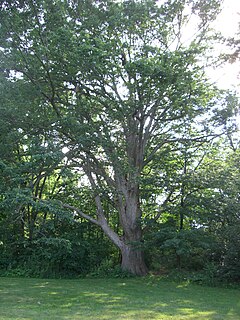
Quercus montana, the chestnut oak, is a species of oak in the white oak group, Quercus sect. Quercus. It is native to the eastern United States, where it is one of the most important ridgetop trees from southern Maine southwest to central Mississippi, with an outlying northwestern population in southern Michigan. It is also sometimes called "rock oak" because of its presence in montane and other rocky habitats. As a consequence of its dry habitat and ridgetop exposure, it is not usually a large tree, typically 18–22 m (59–72 ft) tall; occasional specimens growing in better conditions can however become large, with trees up to 40–43 m (131–141 ft) tall known. They tend to have a similar spread of 18–22 m (59–72 ft). A 10-year-old sapling grown in full sun will stand about 5 m (16 ft) tall. This species is often an important canopy species in an oak-heath forest.

Quercus velutina, the eastern black oak or more commonly known as simply black oak, is a species in the red oak group of oaks. It is widespread in eastern and central North America, found in all the coastal states from Maine to Texas, inland as far as Michigan, Ontario, Minnesota, Nebraska, Kansas, Oklahoma, and eastern Texas.
White oak, White Oak or Whiteoak may refer to:
Red oak, Red Oak or Redoak may refer to:
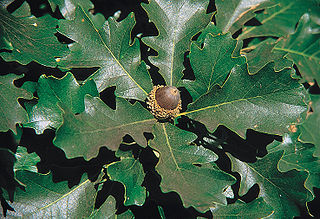
Quercus macrocarpa, the bur oak, sometimes spelled burr oak, is a species of oak in the white oak section Quercus sect. Quercus, native to North America in the eastern and central United States and eastern and central Canada. This plant is also called mossycup oak and mossycup white oak.

Quercus glauca, commonly called ring-cupped oak or Japanese blue oak, is a tree in beech family (Fagaceae). It is native to eastern and southern Asia, where it is found in Afghanistan Bhutan, China, northern and eastern India, southern Japan, Kashmir, Korea, Myanmar, Nepal, and Vietnam.

Quercus coccinea, the scarlet oak, is an oak in the red oak section Quercus sect. Lobatae. The scarlet oak can be mistaken for the pin oak, the black oak, or occasionally the red oak. On scarlet oak the sinuses between lobes are "C"-shaped in comparison to pin oak, which has "U"-shaped sinuses and the acorns are half covered by a deep cap.

Quercus ilicifolia, commonly known as bear oak or scrub oak, is a small shrubby oak native to the eastern United States and southeastern Canada. Its range extends in the United States from Maine to North Carolina, with reports of a few populations north of the international frontier in Ontario. The name ilicifolia means "holly-leaved."
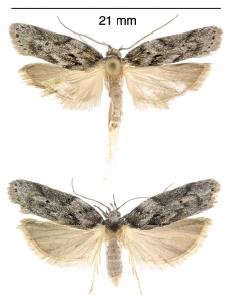
Antaeotricha arizonensis is a moth of the family Depressariidae. It is found in the United States in the mountain ranges in south-eastern Arizona and south-western New Mexico.
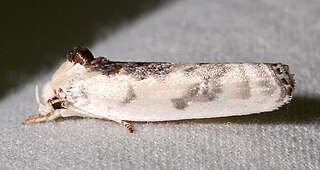
Antaeotricha is a genus of moth. It is the largest genus in the subfamily Stenomatinae, numbering over 400 species in the Western Hemisphere.
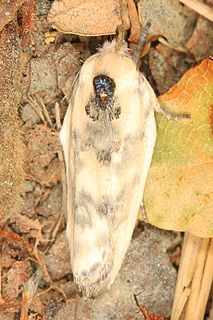
Antaeotricha schlaegeri, the Schlaeger's fruitworm moth, is a species of moth of the family Oecophoridae. It is found in north-eastern North America, south to North Carolina and west to Kansas and Texas.
Coptotriche zelleriella is a moth of the family Tischeriidae. It was described by James Brackenridge Clemens in 1859. It is found in North America in Ontario, Quebec, Arkansas, the District of Columbia, Florida, Illinois, Kentucky, Massachusetts, Missouri, New Jersey, New York, North Carolina, Ohio, Pennsylvania, Texas, Virginia and West Virginia.
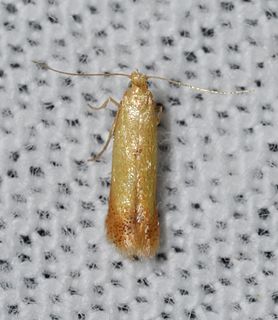
Coptotriche citrinipennella is a moth of the family Tischeriidae. It was described by James Brackenridge Clemens in 1859. It is found in North American in Nova Scotia, Ontario, Quebec, Arkansas, the District of Columbia, Indiana, Kentucky, Massachusetts, Missouri, New Jersey, New York, North Carolina, Ohio, Pennsylvania, Texas, Virginia and West Virginia.

Quercus sinuata, the bastard oak, bastard white oak, or Durand oak, is a North American species of oak. It is native to northern Mexico as well as to the southeastern and south-central United States.

Antaeotricha floridella is a moth of the family Depressariidae. It is found in North America, where it has been recorded from peninsular Florida.
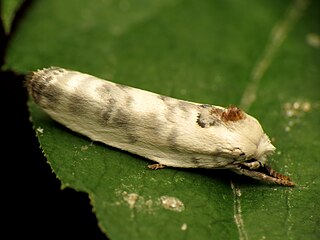
Antaeotricha leucillana, the pale gray bird-dropping moth, is a moth in the family Depressariidae. It was described by Philipp Christoph Zeller in 1854. It is found in North America, where it has been recorded from New Hampshire, Massachusetts, New York, Pennsylvania, District of Columbia, Virginia, North Carolina, Georgia, Alabama, Arkansas, Missouri, Kansas, Illinois, Iowa, Texas, Oregon, Louisiana, Manitoba and Nova Scotia.
Antaeotricha humilis, the dotted anteotricha moth, is a moth in the family Depressariidae. It was described by Philipp Christoph Zeller in 1855. It is found in North America, where it has been recorded from Alabama, Arkansas, Florida, Georgia, Illinois, Indiana, Kansas, Kentucky, Louisiana, Maryland, Mississippi, New Jersey, North Carolina, Ohio, Oklahoma, South Carolina, Tennessee, Texas, Virginia and West Virginia.
Antaeotricha decorosella is a moth in the family Depressariidae. It was described by August Busck in 1908. It is found in North America, where it has been recorded from New Jersey, Indiana, North Carolina, Florida and Massachusetts.
Antaeotricha unipunctella is a moth in the family Depressariidae. It was described by James Brackenridge Clemens in 1863. It is found in North America, where it has been recorded from Alabama, Arizona, Florida, Illinois, Indiana, Louisiana, Maine, Massachusetts, Mississippi, South Carolina, Tennessee and Texas.





